
Community Service Office Harvey Moos advises residents on what they can do to handle wildlife issues, including loans of live traps like this one. (Photos/Nancy Hanson.)
Nancy Edmonds Hanson
Whether or not you’re among the Moorheaders who treasure the sight of wandering deer or itinerant turkeys, wildlife visitors are a perennial fact of life in our riverside city.
It remains a contentious issue for some. But two years after residents packed City Hall to debate the future of the city’s burgeoning wild turkey flock, a change in the ordinance that governs the feeding of wildlife has apparently eased citizens’ concerns and reduced nuisance calls about the birds to the Moorhead Police Department.
From the beginning of the debate, the department’s responsibility has been clear. “Our position is that we do not manage wildlife,” Assistant Chief Tory Jacobson asserts. “We don’t have the personnel or the resources. That’s strictly the job of the Department of Natural Resources.”
Instead, he was tapped to develop a wild turkey management plan in collaboration with the DNR. The city council adopted their recommendations 18 months ago … and they seem to be working.
Key to the plan was a change in the city ordinance regarding the feeding of wildlife. The original statute barred putting out grain, hay and other edibles for deer. It was broadened to include all kinds of wildlife.
Feeding backyard birds was explicitly exempted. Instead, the revised ordinance cut out the practice of providing free lunch for the ground-feeding turkeys, along with deer of limited stature. Now all feeders must be suspended at least five feet above the ground.
And just like that, the problem began to diminish.
“Wild turkeys are smart, and they’re creatures of habit,” Community Policing Officer Harvey Moos observes. “They go where the food is. When neighbors put out food for them, they learn to congregate in the area. When it’s not there, they hunt for their meals in their own habitat.”
While deer have always nibbled greenery on the river’s banks, the turkey crowds have swelled over the years. Both Jacobson and Moos, who is a civilian employee of the department, have spent 30 years on the job here. They agree the turkey population has grown, due in part to DNR efforts to increase the number of birds for sport hunting, as well as their normal migration routes along the river.
But well-meaning human generosity – in the form of free backyard buffets — interferes with their inborn instincts. “They have to survive. Safety, shelter, food. That’s the good life for these birds,” Jacobson points out. “People had been drawing them further and further into the city by enticing them with easy food sources.
“Now that that has stopped, we’re seeing them gradually go back to their natural habits. It will take a few more years to break the habit, but we definitely see improvement.”
One of those signs is a dramatic reduction in nuisance calls. Those calls fall to Moos, along with fellow community service officer Jay Siebel and the four police cadets. Occasionally, callers demand the officers remove animals they deem to be a nuisance – something Jacobson emphasizes is not the department’s job. This year, though, calls for service are down to a bare minimum.
When Moos talks with callers, he explains that animal removal is not officers’ responsibility. Instead, he says, he offers education and suggestions.
In the case of other types of wildlife like muskrats, raccoons or skunks, that may include the loan of live traps to capture the critters to be moved outside the city. Only in the case of a badly injured animal does the department weigh euthanizing them, something that’s outside their normal scope but allowed through a permit issued by the DNR. Deer struck by cars is the most obvious example. That is vanishingly rare.
In the case of occasional complaints of fur-bearers damaging the banks of waterways along the golf course and in other spots, the department’s advice is simple: Hire a trapper. The police can’t help relocate them.
The best advice when it comes to living peacefully with wildlife, Moos says, is to leave them alone. “Ignore them, and they’ll ignore you,” he says. When he investigated persistent claims of turkeys harassing a mail carrier last year, he determined that the man had been throwing rocks at them to shoo them away. He tracked down the alleged miscreants and walked behind them for blocks. “They didn’t even look at me,” he reports. “They were just mad at him because he’d attacked them.”
Jacobson agrees: “We have had no instances of aggressive wild animals in recent years – zero. Our problems are with domestic animals, mostly dogs. No other animal is more aggressive.”
Residents who do want to report a problem with turkeys or a nest on their property can contact the department online at https://cityofmoorhead.com/how-do-i-/report/wild-turkey-nuisance/.
In the meantime, the officers recommend that the best course of action for most Moorheaders is to relax and enjoy their four- and two-legged visitors, like the flock that Moos says meanders through his own yard nearly every day.
“They’re a beautiful part of the natural environment that people value here in Greater Minnesota,” Jacobson points out. “A large part of our population values that highly.”


